There are 23 snakes that have made New Jersey their home.
If you are wondering if the snake in your yard is venomous or not, or you want to identify the snake and learn about it, then continue reading to find out more.
Table of Contents
Are There Venomous Snakes in New Jersey?
Out of the 23 snakes in New Jersey, only 2 are venomous. The two venomous snakes are the Northern Copperhead and the Timber Rattlesnake.
A bite from either of these snakes is a medical emergency and you should seek immediate medical attention.
Types of Snakes in New Jersey
The 23 snakes you may encounter in New Jersey include:
1. Northern Copperhead
The Northern Copperhead is one of the venomous snakes you may encounter in the northern regions of New Jersey.

They grow to 53 inches (135cm) with keeled dorsal scales and an hourglass pattern that runs down the length of their body. The chestnut cross bands are narrower in the center and wider on the sides with dark spots between the cross bands.
They have a copper-colored head with juveniles being lighter in color with yellow on the tip of their tails.
The Northern copperhead is a quiet and lethargic snake that will remain motionless or retreat slowly if encountered. They will strike if they feel agitated or threatened.
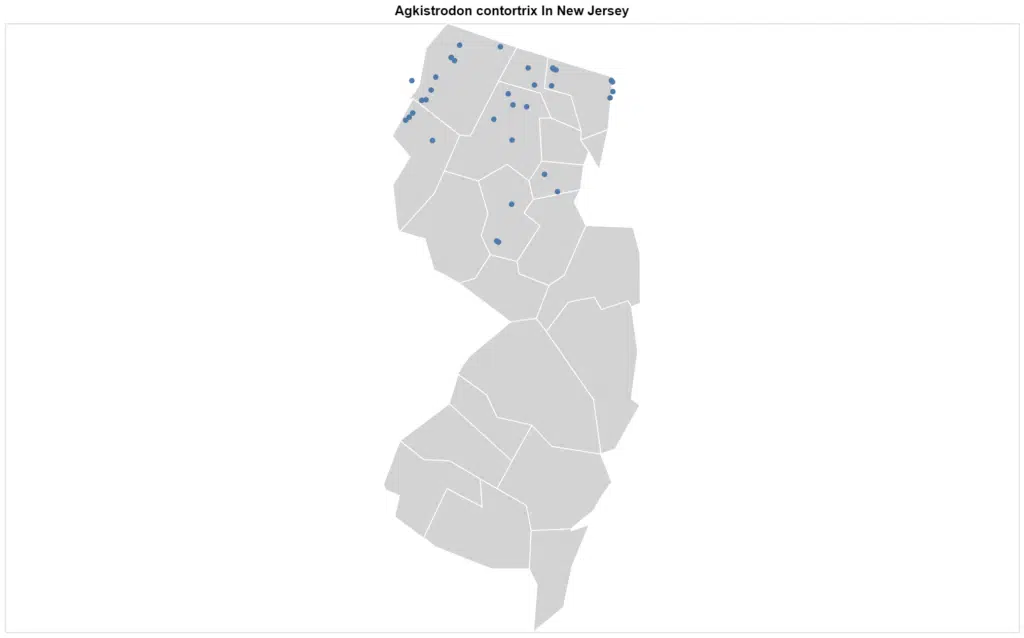
They live in woodlands, farmlands, old mulch piles, rocky fields, and berry thickets.
Further Reading:
2. Timber Rattlesnake

The Timber Rattlesnake can grow to 60 inches (152cm) in length and can weigh up to 1,500 grams.
They have keeled dorsal scales with a dark brown to black cross band pattern on a yellow-brown to gray background. The crossbands are irregular with zig zag edges, some have a V or M shape.
They have a yellow belly with black markings.
Females bask in the sun in open rocky areas when they are about to give birth.
They brumate (hibernate) in dens during winter.
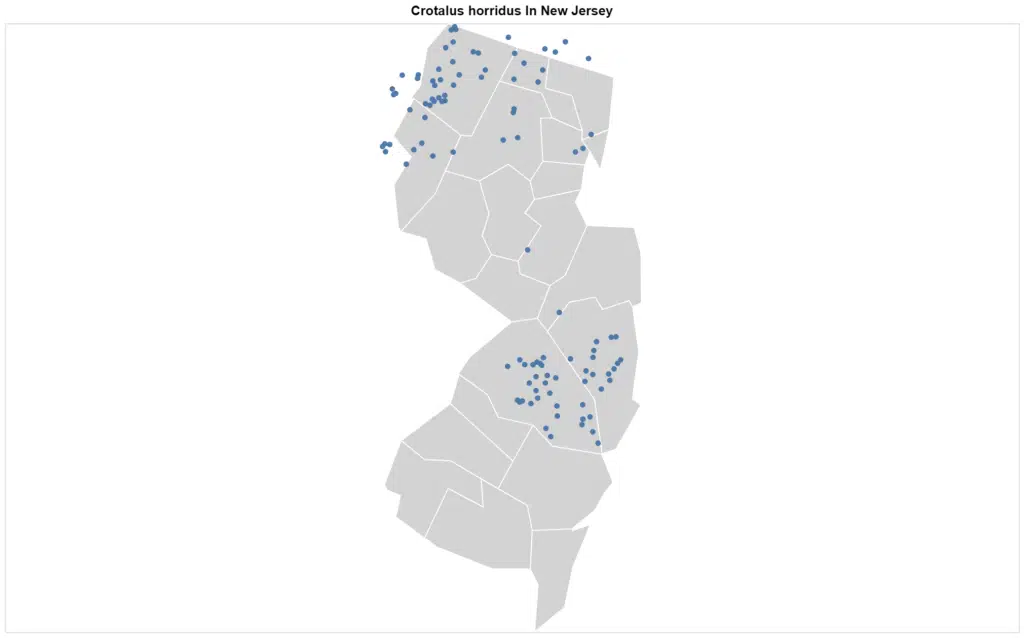
The timber rattlesnake can be found in the northern regions of New Jersey, along the Kittatinny Ridge, and inside the Highlands region. In Southern New Jersey they are common in the Pine Barrens.
In Northern New Jersey you may encounter this venomous snake in the wooded and rocky areas where they hunt in the forests. In the southern regions, they prefer pine-oak forests and swamps, sometimes they are seen basking on dirt roads.
3. Eastern Worm Snake

Eastern Worm Snakes can grow to 13 inches (34cm) with smooth and glossy scales. Their color can vary from tan to dark brown. They have small heads with black eyes that are reduced.
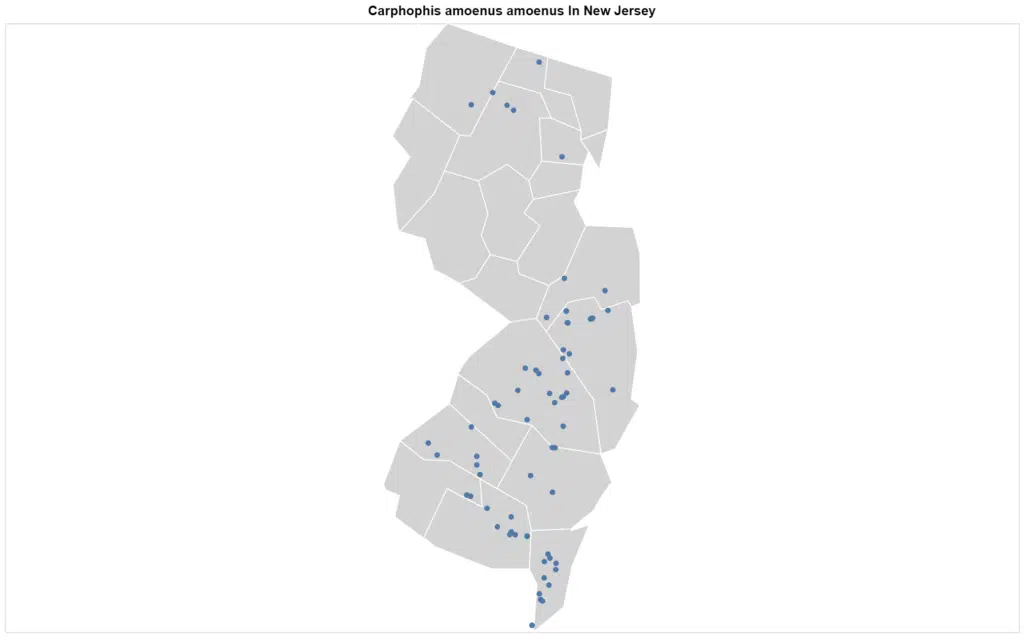
The Eastern worm snake can be found throughout the state of New Jersey, in both rural and suburban areas, though they are seldom seen. They hide in moist soil, under boards, rocks, logs, and stones.
Further Reading:
4. Northern Scarlet Snake

The Northern Scarlet Snake belongs to the Colubridae family and can grow to 20 inches.
These non-venomous snakes are tri-colored snakes with bright red, yellow, and black banding. The red bands do not touch the yellow bands and they do not encircle the entire body. The belly is solid gray, pink, or white with red heads and pointed snouts.
They are uncommon in New Jersey and seldom encountered, only coming out at night to feed. They prefer forest habitats and are excellent burrowers, hiding under logs, leaf litter, rocks, and trash
5. Northern Black Racer
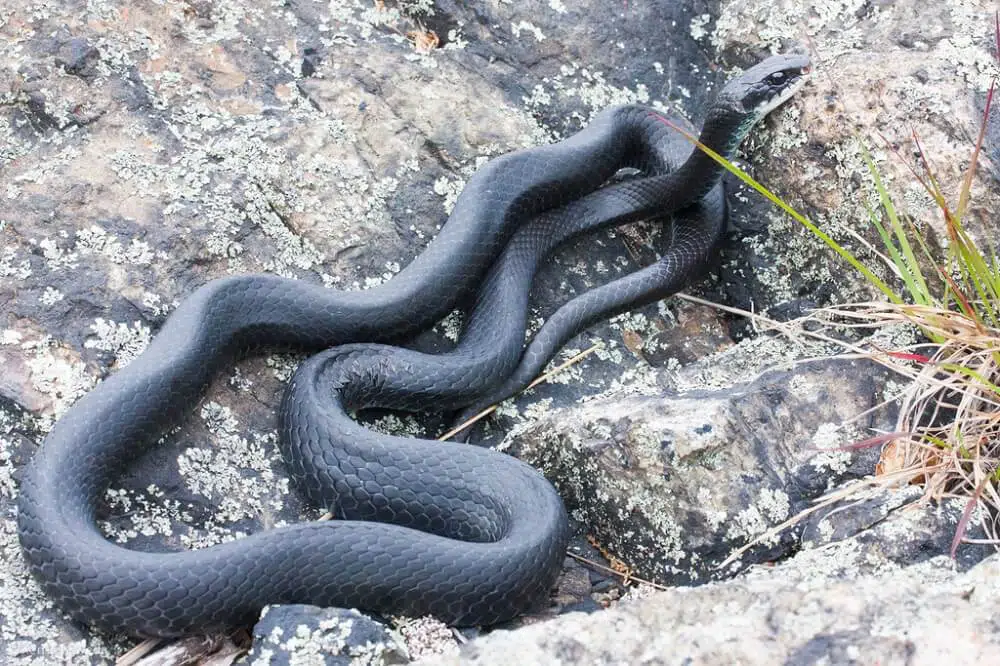
Black Racers can grow to 60 inches (152cm) and can weigh up to 556 grams. Most are solid in color with a light belly in tan or yellow.
Juveniles have striking patterns with dark blotches on their backs with a light background.
These are fast-moving and active snakes that eat rodents, lizards, frogs, and toads. They have excellent vision and are curious, often seen holding their heads above the grass.
They will flee from danger. If captured, they give off a foul smell, while vibrating their tails on dry leaves to make them sound like a rattlesnake.
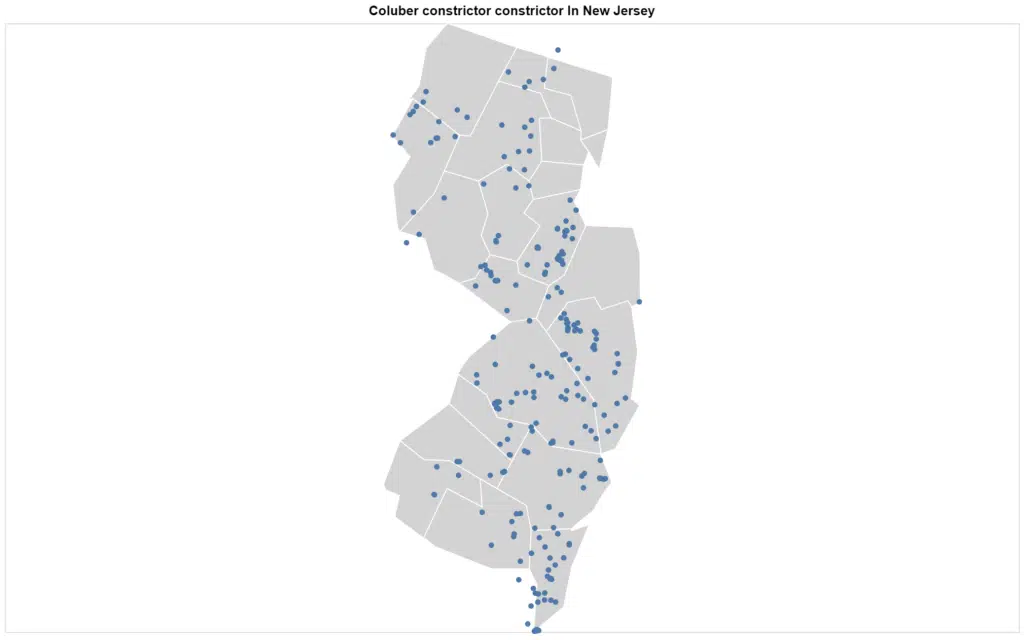
They are usually encountered near water, trash piles, swamps, and in some neighborhoods. They are common in New Jersey, especially in Warren County.
6. Southern Ringneck Snake

Southern Ringneck Snakes are small and slender snakes that are gray with a yellow or orange broken band around their necks and on their belly. They grow to 15 inches (38cm).
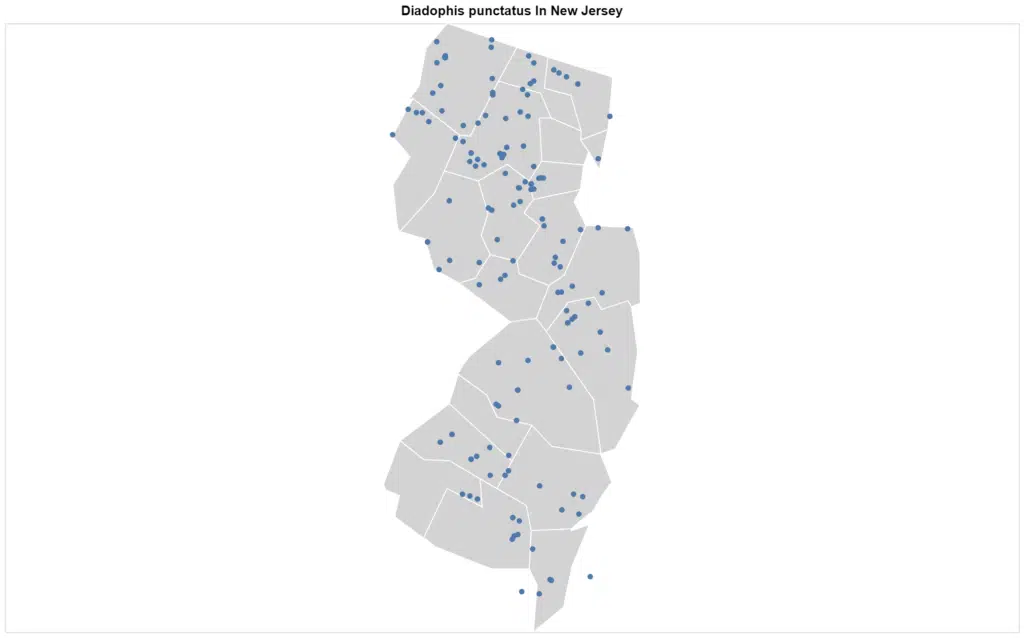
They are found throughout New Jersey and can be encountered in just about any habitat including wooded areas, river floodplains, hardwood forests, and wetland edges.
7. Northern Ringneck Snake
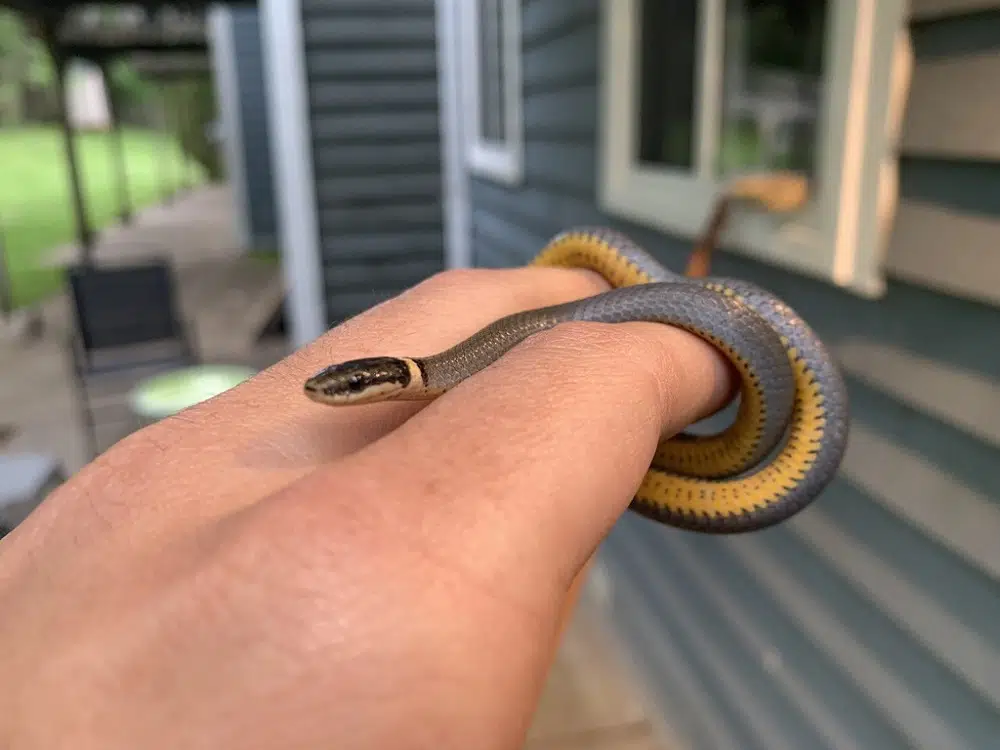
Northern Ringneck Snakes are blue-gray to black in color with a narrow yellow to orange ring around their necks. They have a ring on the belly. They grow to 15 inches (38cm).
They are nocturnal and hide under rocks, fallen logs, and leaf litter, which is why they are not encountered often, even though they can be found throughout the state of New Jersey.
They are social snakes with multiple ring necks living in one hiding spot. They prefer moist wooded areas and humid basements.
8. Corn Snake

Corn Snakes are large snakes that can grow to 5.97 feet (182cm) and have bright colors, rounded pupils, and are slender in build.
Their habitats include forest openings, flat woods overgrown fields, and trees, they also sometimes move in abandoned buildings.
They remain on the ground until they are around four months and then they start ascending trees and other elevated surfaces, such as cliffs.
They are endangered in New Jersey, found in the Pine Barrens.
9. Black Rat Snake
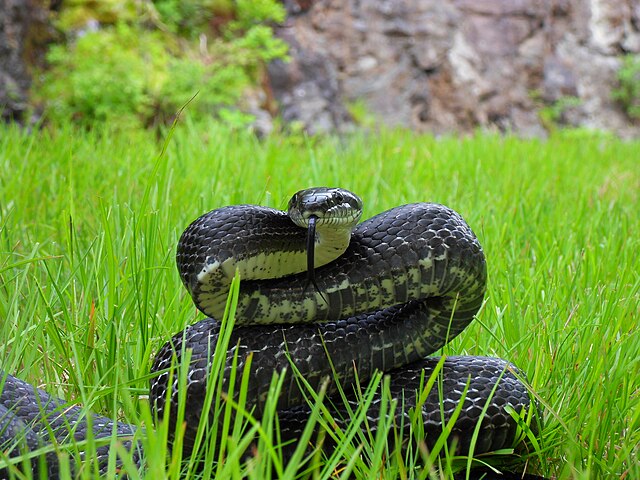
Black Rat Snakes are large snakes growing to 7 feet in length with shiny black scales on their backs and a lighter colored belly. The throat and chin are white. Their heads are wider than their necks.
They are excellent climbers and swimmers, which enables them to catch a variety of food, including frogs and bird eggs.
If captured or threatened, they give off a foul smell.
This is the largest snake in New Jersey and is common in rural and semi-urban areas.
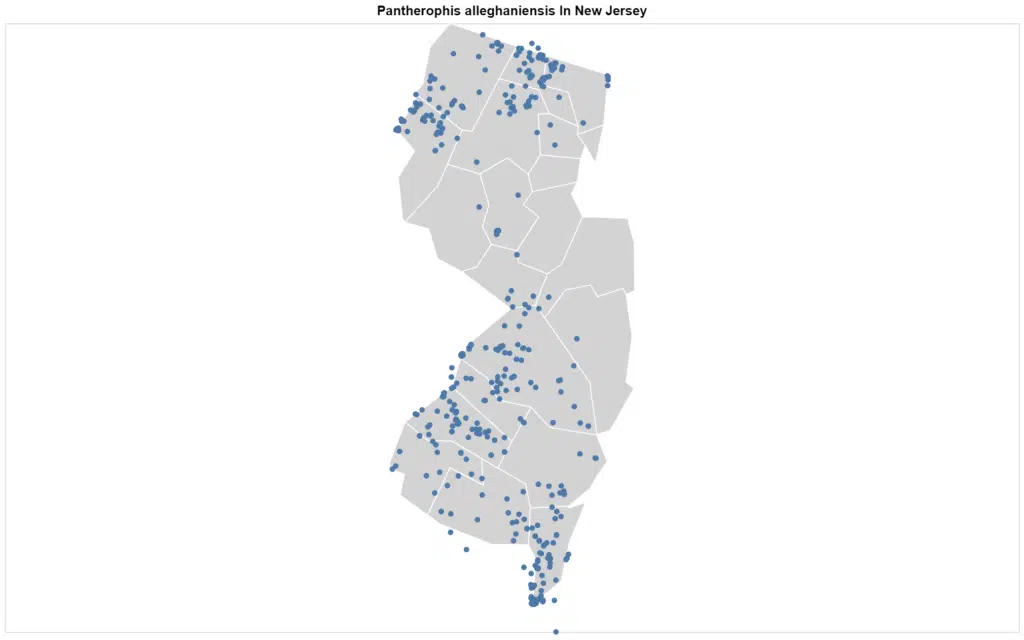
10. Eastern Hognose Snake

The Eastern Hognose can grow to 28 inches (71cm) in total length with females being larger than males.
They have an upturned snout, which helps them dig in sandy soil.
Their color is variable and can range from green or orange to black or gray or red, sometimes a combination of the colors. Their patterns can be checkered, blotchy or they may have no patterns. Their belly is a solid yellow, cream, or gray.
When threatened they mimic a cobra by lifting their heads and flattening their necks while hissing and striking, though they seldom bite. If this doesn’t work, the snake rolls on its back and plays dead, while giving off a foul smell.
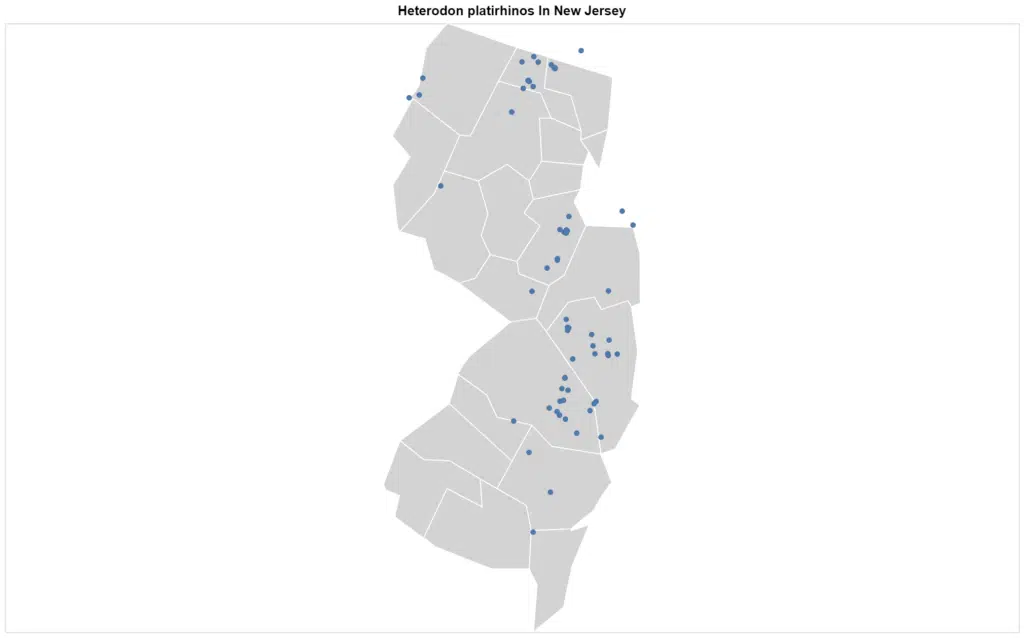
They are found in twenty-one of the New Jersey counties, where they live in wooded hills, forest edges, woodland meadows, river valleys, and fields.
11. Eastern Kingsnake
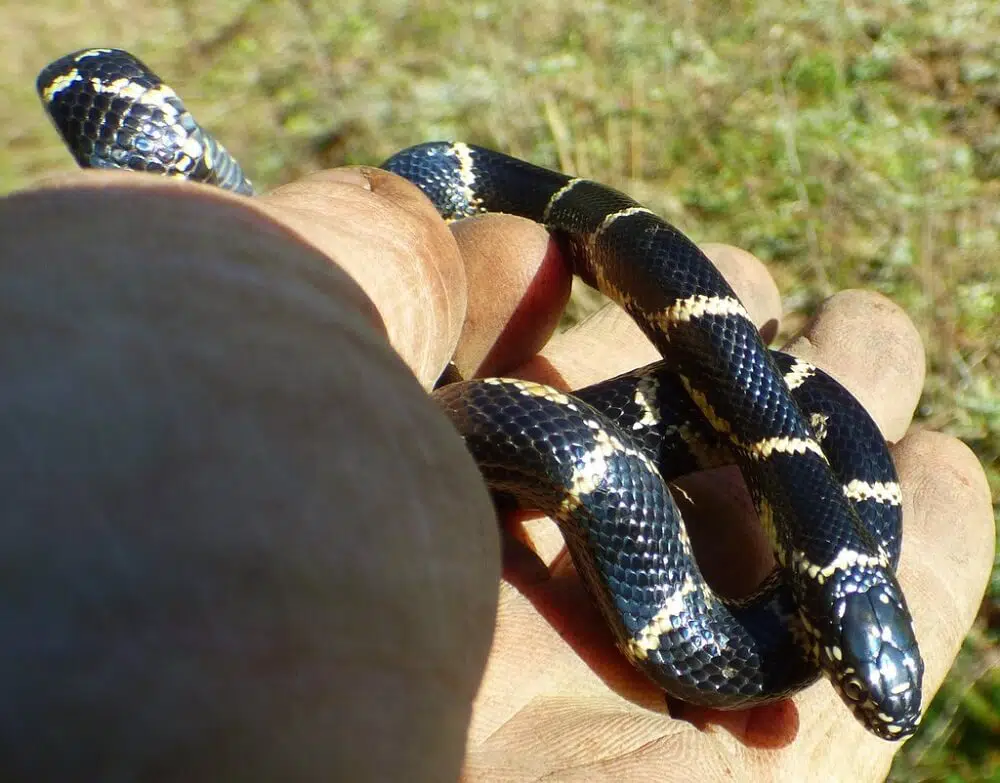
The Eastern Kingsnake can grow to 36 inches (91cm) and weigh up to 285 grams. They are glossy blue/black, black, or dark brown with wide bands.
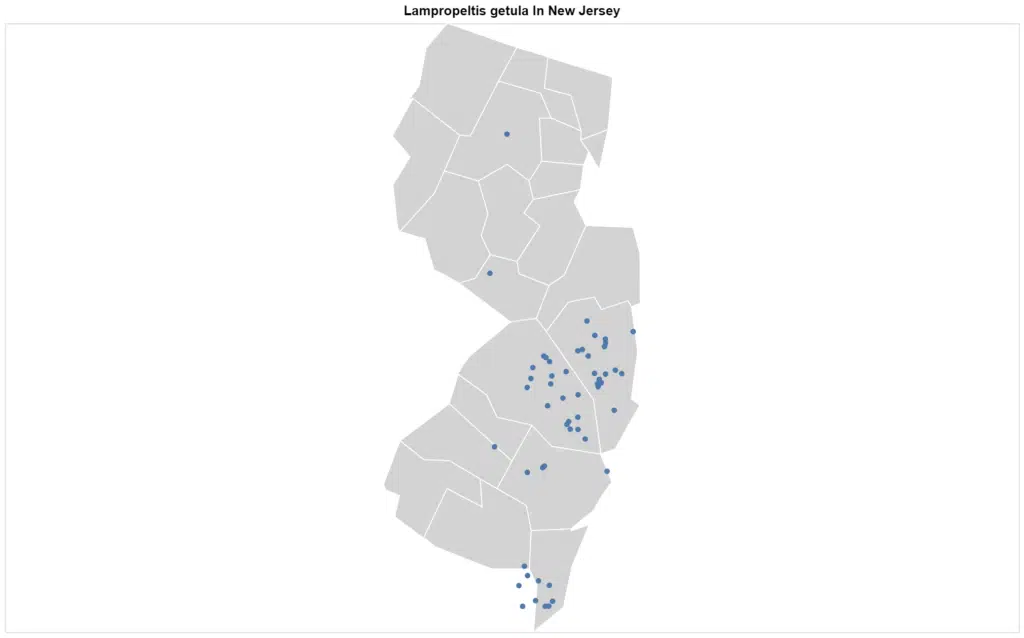
They prefer open areas, such as grasslands, oak woodlands, abandoned farms, low mountains and swamps, streams, and canals. They are found in the southern region of New Jersey and are commonly encountered.
12. Coastal Plain Milk Snake

Coastal Plain Milk Snakes can grow to 52 inches (132cm) with the males being larger than the female.
They are smooth and shiny with alternating bands of red, black, and yellow or white, black, and red.
They are sometimes misidentified as coral snakes.
They prefer forested areas and open prairies; some live on rocky slopes. They are nocturnal and blend in with the ground litter. They are secretive and tend to remain hidden If threatened, they try and escape.
If provoked, they vibrate their tail, mimicking a rattlesnake, though they are completely harmless to humans.
They are common in the Pine Barrens and sandy soil in the New Jersey Coastal Plain.
13. Eastern Milk Snake

Eastern Milk Snakes grow to 36 inches (91cm) with shiny and smooth scales. Their color pattern is a brown dorsal saddle, edged in black. They have a black and white checkered pattern on their belly.
They are common in the pet trade, as they are docile and rarely bite. They are common throughout New Jersey.
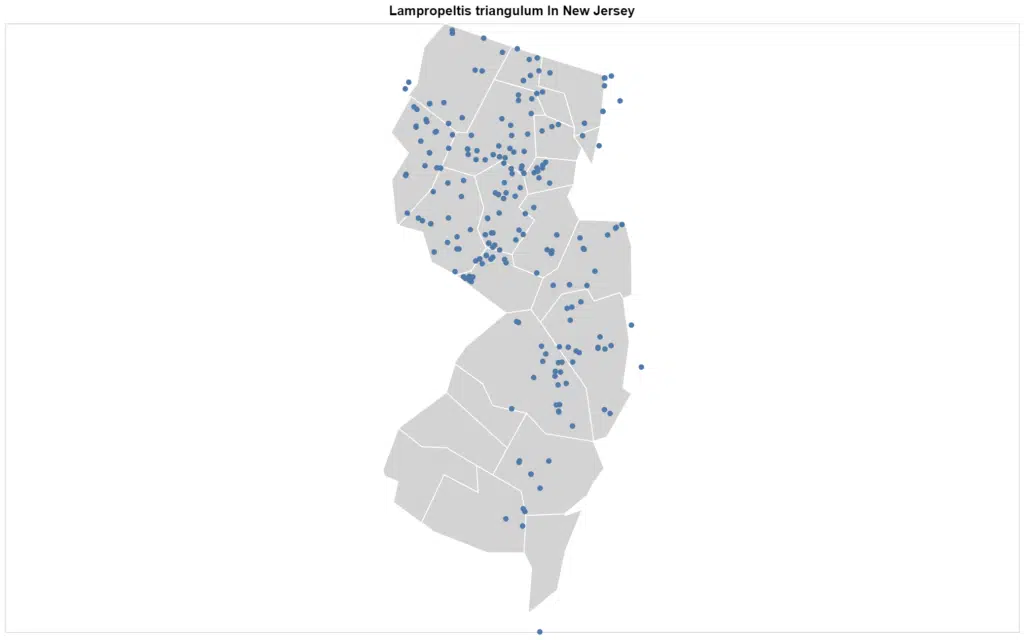
14. Northern Water Snake

Northern Water Snakes can grow to 4ft 5 inches (135cm) and can range from gray or brown to red or brown/black.
They have dark crossbands on the neck with dark patches on the rest of the body. As they age, their colors darken, obscuring the pattern with some changing to black.
Their belly can be yellow, gray, or white with black or red cresents.
These harmless snakes are long and slender with a flattened head, which is the same width as the neck.
They are active day and night and often encountered basking in the sun on rocks or tree stumps. They dive into the water when disturbed, helping them flee from danger.
They can give a painful bite if cornered or captured, they bite repeatedly while giving off a foul smell.
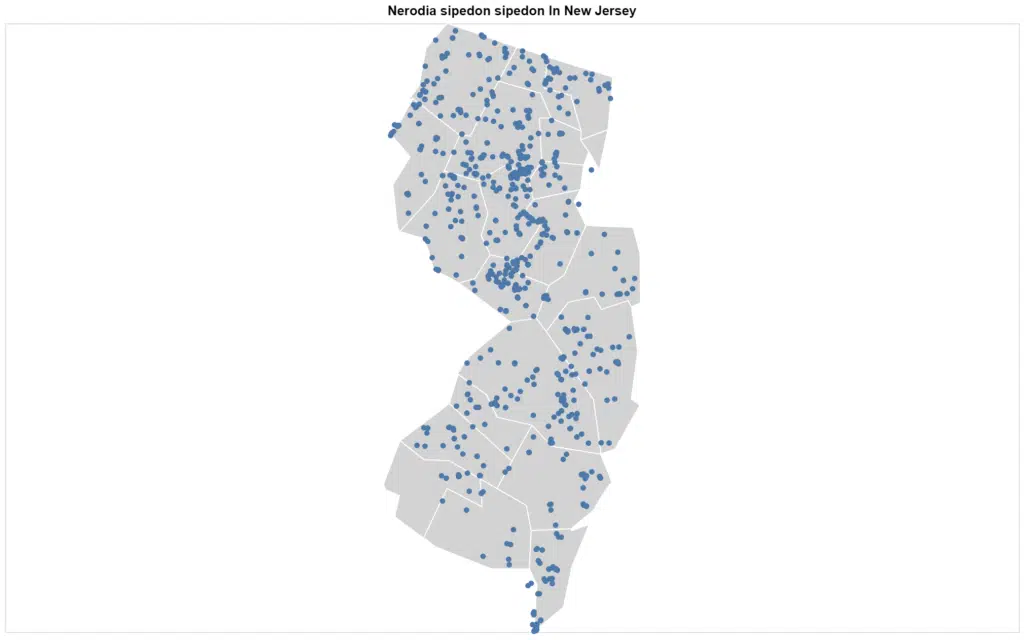
They are often seen in beaver lodges and muskrat houses. They live close to ponds, lakes, rivers, and canals. It is one of the most common snakes in New Jersey and can be found throughout the state.
15. Rough Green Snake

Rough Green Snakes are bright green in color with a yellow belly, helping them camouflage in vegetation and making them hard to see in the wild. They have keeled dorsal scales and can grow to 34 inches (116cm).
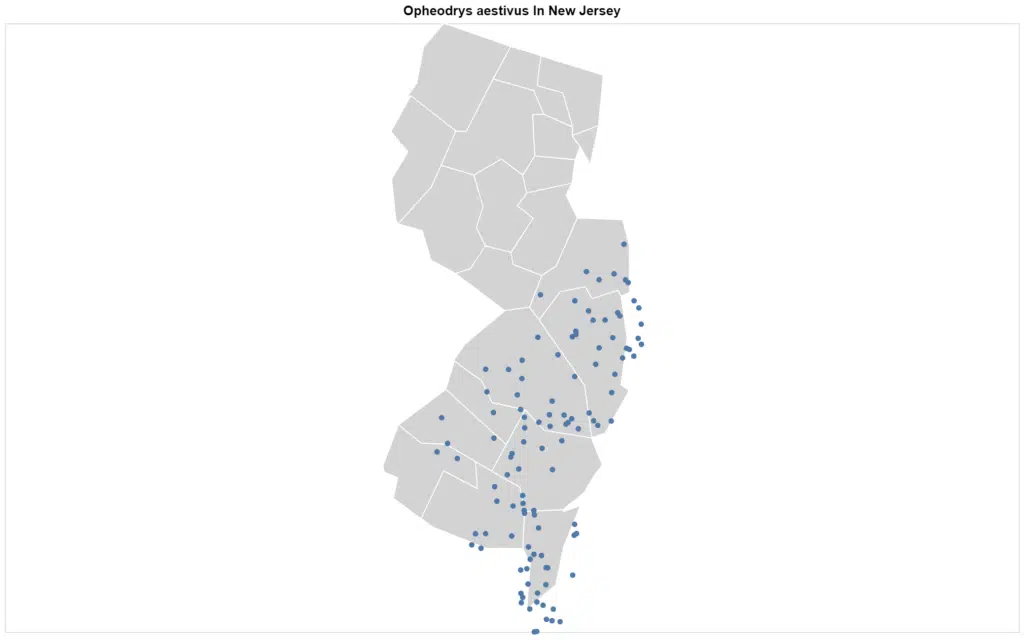
These thin snakes prefer moist meadows and woodlands, usually found near water. They are often found climbing in low vegetation and are excellent swimmers. They are encountered in vegetation that overhangs the water in the southern region of New Jersey.
16. Smooth Green Snake

Smooth Green Snakes are slender, medium-sized snakes that grow to 20 inches (51cm).
Their backs are light green with a white to yellow belly and smooth sales. They are usually blue/gray, brown, or olive green at birth and after they shed for the first time, they become the bright green color.
Their red tongues have black on the end, which they use to smell their surroundings by flicking them in and out.
They are found in a range of habitats from meadows to marshes and open woods to stream edges.
They will flee if threatened, giving off a foul smell.
They are active during the warmer months, both day and night. During colder months they hibernate in grounds, usually using rodent burrows and anthills.
They are mostly found in the northern regions of New Jersey in meadows, grasses, open woods, and habitats where they camouflage into the environment.
17. Queen Snake

Queen Snakes are olive, dark brown, or gray in color with yellow or peach stripes running the length of the first row of scales. They have four dark ventral stripes.
Juveniles have extra stripes, one down the vertebral dorsal sales and one on each side that runs down the body. As the snake ages, the extra stripes fade.
Their belly is cream in color. They have narrow heads.
These snakes grow to around 24 inches (61cm) with females being slightly larger than males.
They are very specific about their habitat requirements and are never found in areas that do not have clean running streams or watersheds that have rocky bottoms.
Their diet is mostly made up of freshwater crayfish, prying on newly molted crayfish, which are unable to defend themselves. Freshwater crayfish make up around ninety percent of their diet, the remaining ten percent includes snails, fairy shrimp, tadpoles, and frogs.
They are not that common in New Jersey due to their specific habitat requirements.
18. Northern Pine Snake
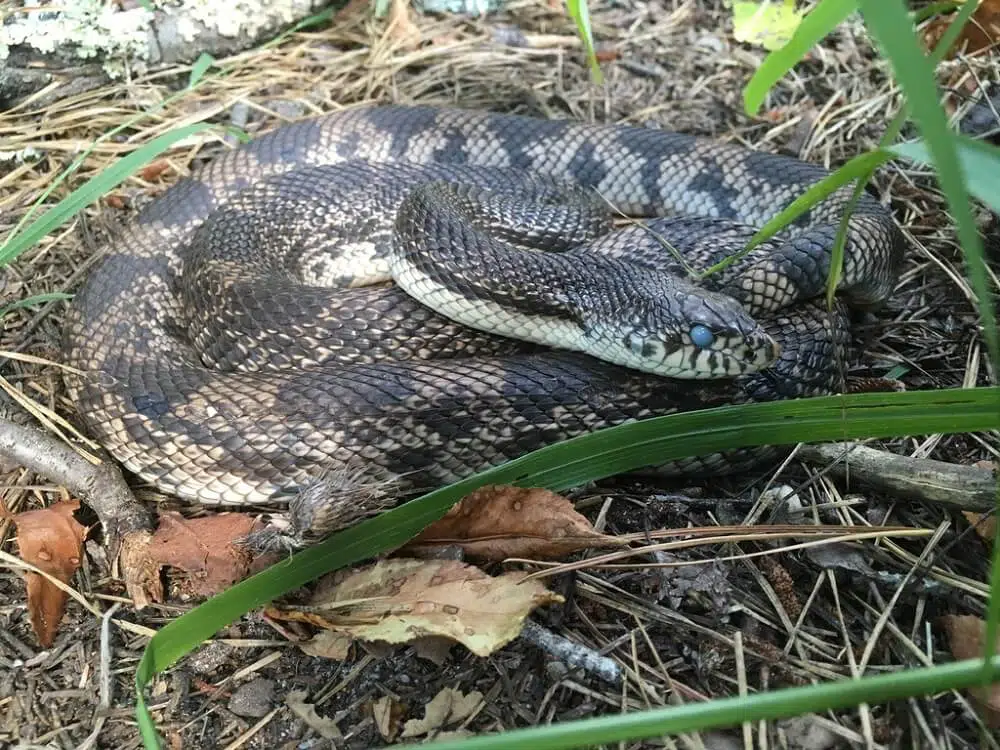
Northern pine snakes can grow to 90 inches (230cm) are powerful in build. They have small heads with a pointed snout. They are light brown in color with black or red to brown color patches.
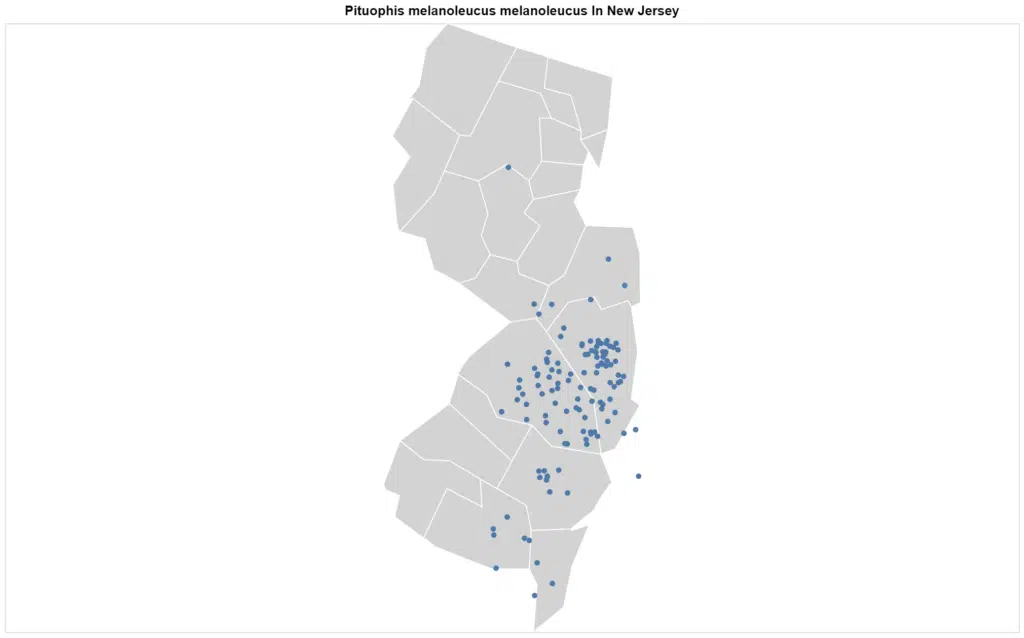
These snakes can be found in pine flat woods, prairies, pine-oak woodlands, cultivated fields, rocky deserts, chaparral, and open brushlands. They need well-drained sandy soil for hibernating and nesting.
The Northern pine snake is a threatened species in New Jersey found in the Pine Barrens.
19. Northern Brown Snake

Northern Brown Snakes grow to 5 feet (1.8 meters) and are orange-brown in color with flecks and bands. Their bellies are cream or orange with pink patches. Some have black heads, while others have a black V on the back of their head or just below the head.
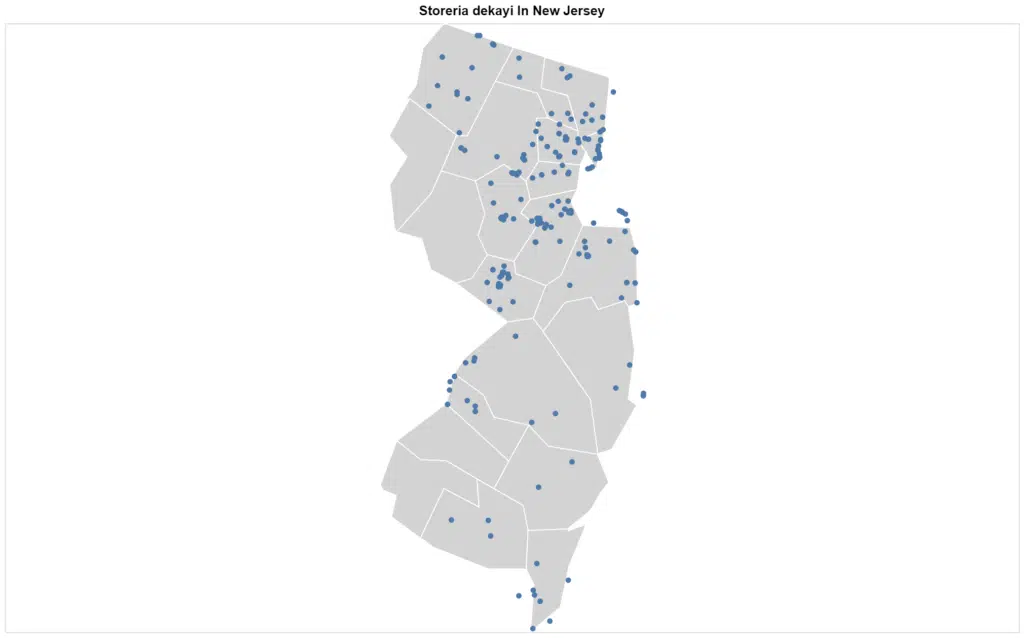
The Northern brown snake is common throughout the State of New Jersey where they remain on the ground in dry habitats, including woodlands and grasslands. They hide in crevices, under rocks, and sometimes under rubbish piles in urban areas.
20. Northern Red Bellied Snake

Northern Red Bellied Snakes are small snakes that grow to around 10 inches (25cm).
They vary in color with some being bright orange, others almost black and then there are those that are brown or gray. Some are gray with an orange or brown stripe down their backs. They have a bright red to orange color on their belly.
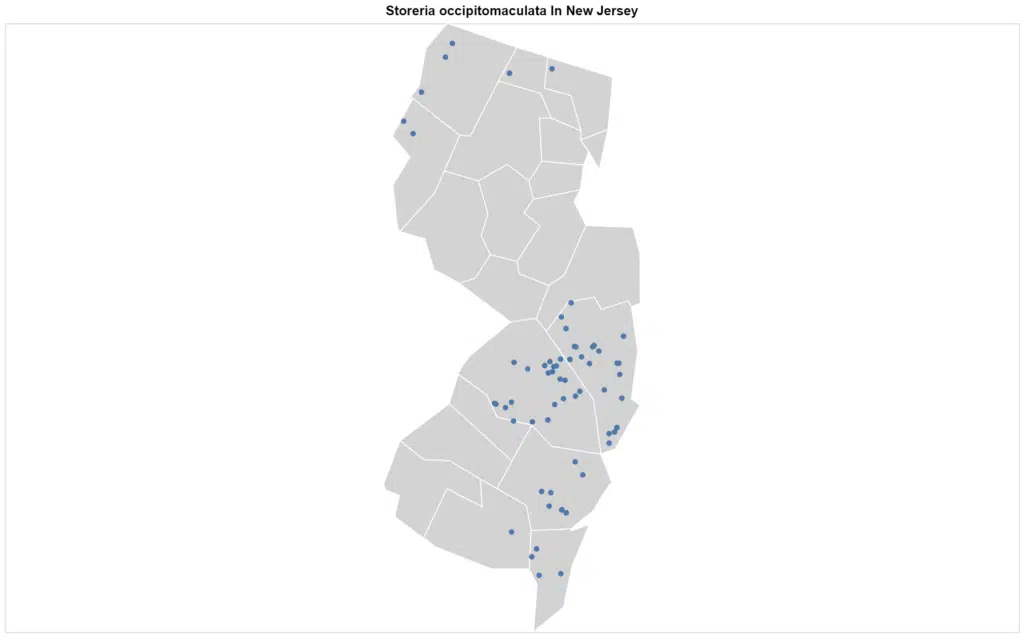
While they are common throughout New Jersey, they are not easy to find, being very secretive and hiding under rocks, leaf piles, and logs.
They eat exclusively on slugs.
They curl their lips when threatened with bites being very rare.
21. Eastern Ribbon Snake

Eastern Ribbon Snakes are thin snakes that can grow to 33.9 inches (86cm). They are black with a yellow stripe on their back, along with a stripe on either side.
Their belly is a green to white color, their labial scales around the mouth are bright yellow or white and there is a white or light-yellow bar that borders the eyes.
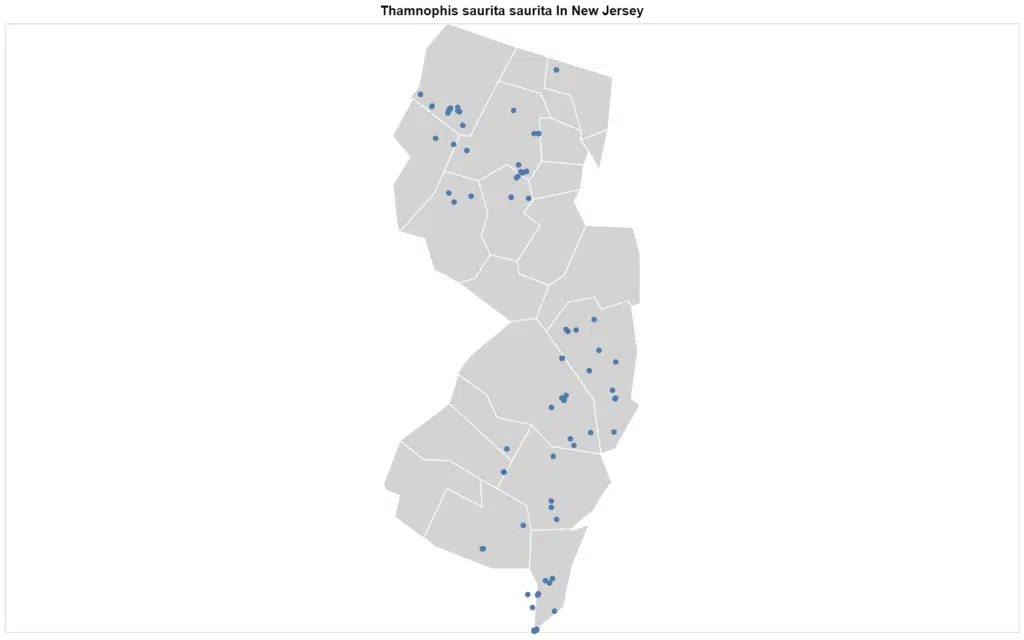
These non-venomous snakes are found throughout the State of New Jersey and are common in wetlands, near ponds and streams. They can be encountered both in and out of the water, which they take to when fleeing from threats. They glide across the water and do not dive like water snakes.
22. Eastern Garter Snake

Eastern Garter Snakes can grow to 48 inches (124cm) with females being larger than males. They can be black, green, or brown with yellow or white stripes.
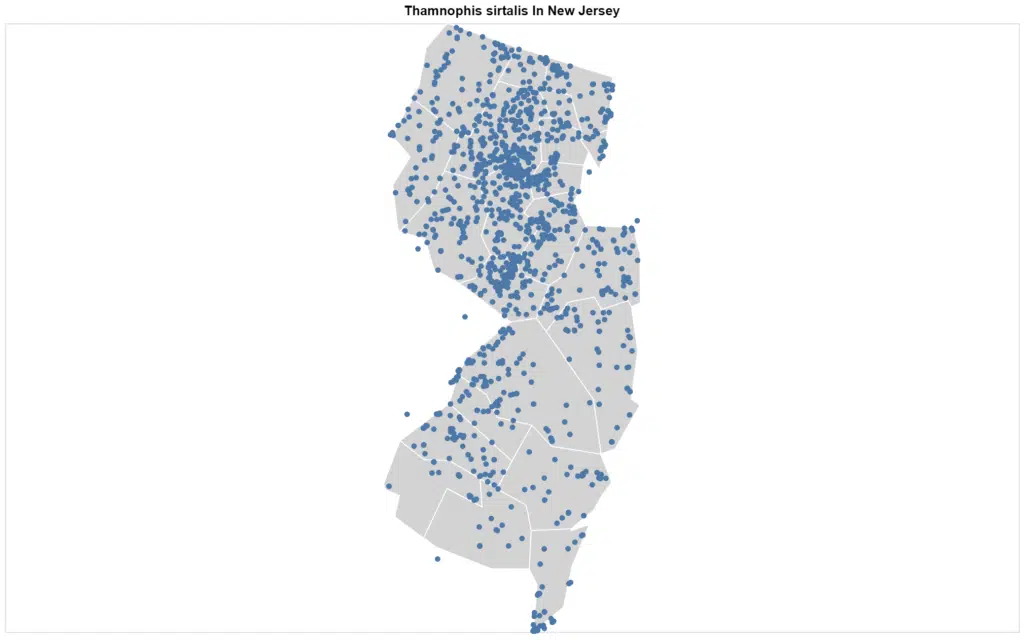
This snake is the most common snake found in New Jersey, usually around the residence, though they prefer shrubby fields, abandoned farmland, and trash dumps.
They can also be encountered in moist habitats, such as along the banks of streams, rivers, ponds, and quarries. They hide under rocks, stones, and debris.
23. Eastern Smooth Earth Snake
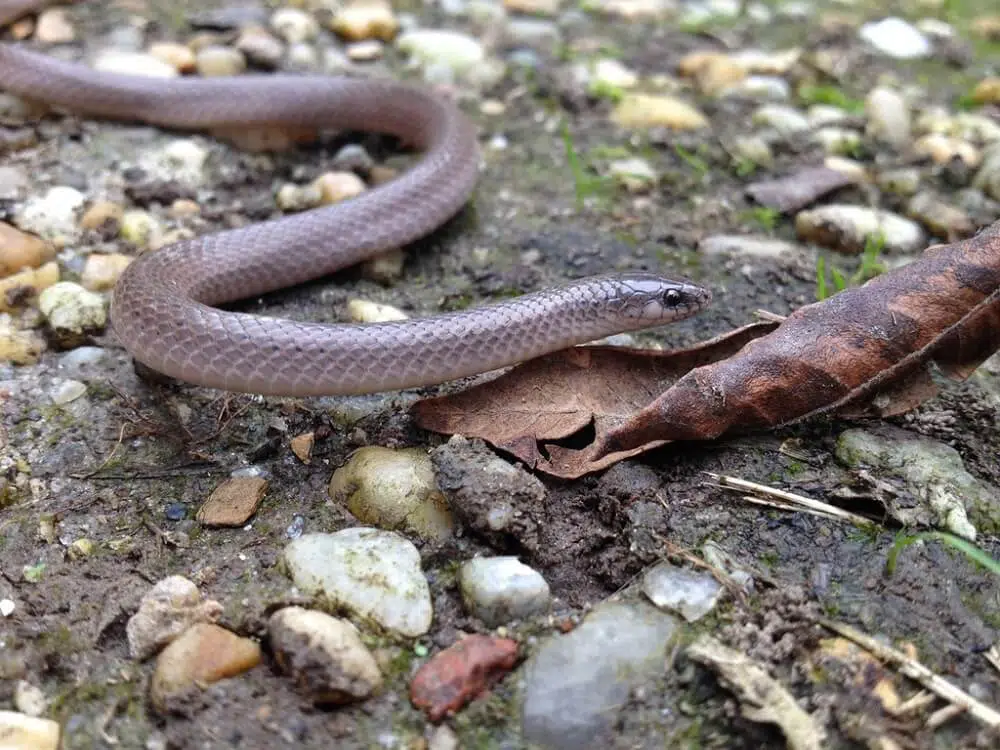
The Eastern Smooth Earth Snake can be dark or light brown with dark spots on the head. They have a black ring around their eyes with the ventral surface of the head is white. Some have a median line with tiny black spots on the back and sites.
They can grow to 33cm, spending the majority of their time hidden in loose soil or under leaf litter.
This is not an aggressive snake and is harmless if you encounter them. They do have teeth and will try and strike, but bites are superficial. They often defecate as their first line of defense.
The Eastern smooth earth snake is common in the Piedmont and Coastal Plains of New Jersey.
What To Do If You See a Snake in New Jersey
If you encounter a venomous snake, the timber rattlesnake or northern copperhead, ensure you keep a safe distance of a minimum of five feet. Young children and pets should be put further back.
They often give what is known as a dry bite, which is a defense action rather than biting for food.
If bitten by one of the venomous snakes in New Jersey, it is important to remain calm and call 911 straight away.
If you encounter any snake in your home, call a snake removal company right away. If you leave the snake, it should not harm you.
Close the windows and doors in the room where the snake is, reducing the risk of it moving around the home, keeping your five-foot distance.
Put a towel under the door to reduce the risk of the snake escaping until the snake removal company arrives.
In the event, you know the snake is not venomous and it’s close to an exterior door, you can try and brush it out. Though keep your distance, as it may turn around and try and bite or flee in the wrong direction.
How to Prevent Snakes
The good news is that there are a number of things you can do to prevent snakes in your home and yard, these include:
- Mow your lawn and keep the grass short, this will help deter snakes and help you identify snake activity.
- Remove any debris piles and mulch. Mulch generates heat as it decomposes, which is a warm spot for snakes, while debris can attract rodents, offering easy food for snakes.
- Feed your pets inside or remove food bowls as soon as your pet finishes eating, reducing the risk of attracting rodents and in turn, attracting snakes.
- Seal any cracks and crevices in the home and ensure your outbuilding foundations are sealed It is common for garter snakes and milk snakes to move into homes during summer months.
- Remove bird houses. While bird houses are beautiful, the chirping can attract snakes to your yard. If you love your bird house, place it on a metal pole or a wooden post, wrapping it in metal sheeting to deter any snakes.
- Reduce the urge to feed wild birds in your yard. Birds are naturally messy, knocking food to the ground and attracting rodents.
- Use your firewood during winter, as they become a great hiding place for snakes during the summer. If you keep firewood throughout the year, place it on a rack at least one foot above the ground.
- If you have fruit trees, ensure you pick up any fallen fruit
Summary
Snakes are common throughout New Jersey with only two being venomous and dangerous to humans: the Northern copperhead and timber rattlesnake.
Being able to identify snakes in the State helps you identify if you need to be concerned or not. Try the preventative measures to reduce the risk of snakes turning your home or yard into their new habitat.
Further Reading: